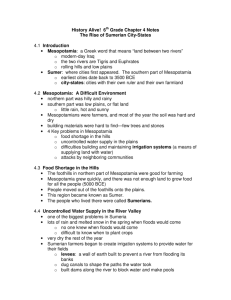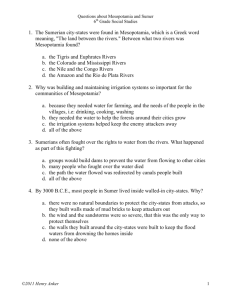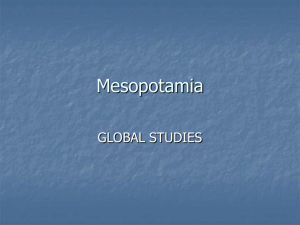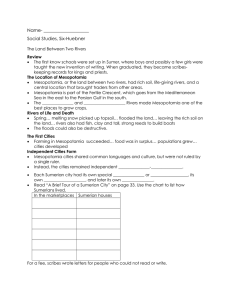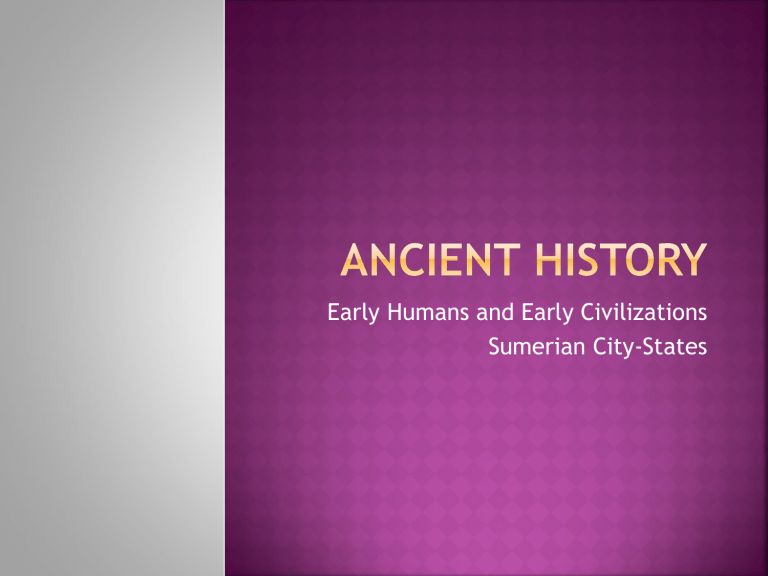
Early Humans and Early Civilizations
Sumerian City-States
Mesopotamia: Greek for land between two rivers. In modern day Iraq.
Sumer: Southern Mesopotamia. The site of the first large complex cities.
City-States: Small, independent countries, each with their own ruler and their own farmland.
Irrigation System: a way to supply land with water.
Sumerians: Ancient people who lived in Sumer.
Levee: A wall of Earth built to prevent a river from flooding its banks.
Some of the small villages from the Neolithic times grew into large complex cities.
They were located in sumer, the southern area in Mesopotamia. Mesopotamia means the land between two rivers. The two rivers are the Tigris and the Euphrates Rivers.
The earliest cities in Sumer began around
3500 BCE. They were small, independent countries, each with a ruler and farmland of their own. They were called city-states.
Imagine you are visiting one of the earliest citystates in Sumer. You see a walled settlement surrounded by farmland. The walls are made of bricks baked in the sun and the farmland is supplying the food for the city. There are moats filled with water around the walls for protection.
On a piece of paper answer the following questions using prediction skills. When you predict something you are making an educated guess as to the answer before reading to find the answer out.
Why didn’t the people here continue to live in small villages? Why build giant cities?
Why did they choose this area to build their cities?
Mesopotamia was not an easy place to live.
The north was full of hills and received rain.
The Southern part was low, flat plains. The sun was hot and the land dry between the two rivers.
It did not rain as much in the Southern areas.
It was difficult to find materials to build shelters.
There were no trees for wood and stones were scarce.
There were not a lot of natural barriers for protection.
Mesopotamians faced four key problems trying to survive in the harsh environment.
Over time they overcame these problems and the result was some of the first cities in the world.
Think of a problem that you or your family have faced, and what you did to solve that problem.
Fold a piece of construction paper in half.
On the left side draw a picture of the problem you faced.
On the right side draw a picture of the solution you came up with to solve the problem.
Make sure to write an explanation of one or two sentences below each picture.
Mild weather and lots of rain made the
Zargos Mountains in Northern Mesopotamia a good place to farm.
There was plenty of trees to build shelters and plenty of stones for tool making.
These conditions helped this area grow over time.
In about 5000 BCE there were more farmers and more people than the Zargos Mountains could provide food for. There was not enough land for farming, yet the number of people living there increased.
As a result villages began to have food shortages.
Driven by the need for more food, the people fled the Zargos Mountains and settled in the
Southern plains between the Tigris and
Euphrates rivers.
This region became known as Sumer and the people there were Sumerians.
South of the Zargos Mountains were low, flat plains between the Tigris and Euphrates
Rivers.
It was a large land and had harsh conditions.
During most of the year the land was dry and the soil hard. It was not good farmland.
There were not a lot of trees for building wood or stones for tool making.
People settled here anyhow in search of food and eventually this became the place where the first cities were built.
During the spring, when the snow melted and the rain came, the water flowed into the
Tigris and Euphrates Rivers. This caused them to overflow across the plains.
No one knew when the rivers would flood.
If it happened after the farmers planted crops, the crops would be washed away.
This made the farmers constantly struggling to grow crops. They needed a way to control the water supply.
To control the water supply on the plains, farmers created an irrigation system.
They build walls out of packed mud, called levees, along the sides of the rivers. This prevented flooding.
When the land was too dry the farmers poked holes in the levees and then water flowed out onto the dry land.
Over time, the Sumerian farmers learned other ways to control the water supply.
They dug canals and made dams to control water, and they created pools where the water could be stored for future use.
Farmers began to face a new challenge: how to maintain the irrigation system across several villages at once.
The system had to maintained all the time.
Canals had to be cleaned out because they were constantly clogging up with mud.
This meant that farmers had to work together to maintain the system.
Gradually villages that once were separated began to depend on one another. The result was that small, independent villages became large cities. Some cities were as large as several thousand people.
As Sumerian cities grew, people began to fight over how used how much water and when.
Sometimes cities where the water began to flow blocked cities downstream from getting any.
The fighting became so intense that small wars broke out among neighbors.
Individual cities began to look for ways to protect themselves from their neighbors. Since they had no natural barriers they built walls out of mud and bricks baked in the sun. They dug moats outside the walls and filled them with water.
The people lived inside the walls and farmland was outside the walls. When cities were under attack, farmers came inside the walls for safety.
By 3000 BCE most Sumerians lived inside walled cities. Historians called them city-states.
Around 3000 BCE Sumer went from small, independent farming villages to large walled city-states.
This was their solution to the challenges they faced.
This helped with a stable food supply. Controlling the water on the plains, maintaining the irrigation system and protecting themselves from neighbors attacking them.
Using a piece of white paper, create a real estate advertisement or poster encouraging people to move to a Sumerian city-state. Make sure to use clear, complete sentences and proper grammar and spelling. Us different colors and draw exciting pictures.
Make sure your advertisement includes:
A clever, catchy title on the top of the advertisement. It needs to include the words Sumerian City-States.
Two to three drawings representing how Sumerians solved their key problems and why that makes the city state a good place to live.
A short explanation below each drawing describing why the solution makes this city state a good place to live.
You learned how small, independent villages in
Mesopotamia grew into large, walled city-states.
This was the answer to challenges people faced when living in Sumer.
The solutions to their problems led them build large cities called citystates, depend on each other for food and maintaining a controlled water supply and in protecting their cities.
The Sumerians figured out how to work together for the good of the community. This led to the creation of large city-states.
Living in city states led to a new way of life for the Sumerians. Join us as we take a closer look at the culture that developed as a result.
